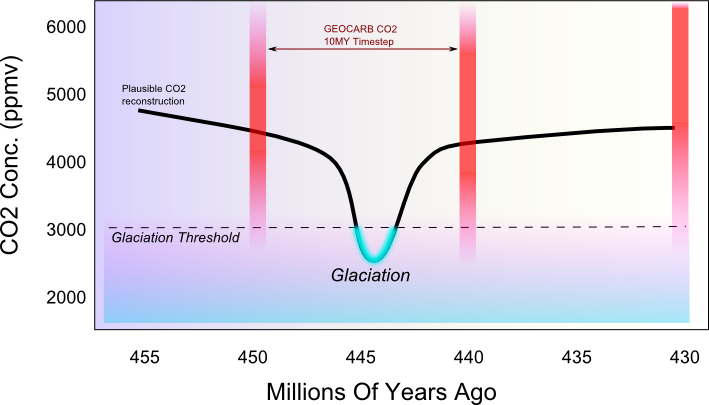Do high levels of CO2 in the past contradict the warming effect of CO2?
Posted on 24 December 2010 by steve.oconnor
Geologists refer to ancient ice-cap formations and ice-ages as "glaciations." One such glaciation that occurred during the Late Ordovician era, some 444 million years ago has captured the attention of climate scientists and skeptics alike. To get some perspective on timing, that's just over 200 million years before dinosaurs began to roam the Earth.
Unlike other glaciations in the last 500 million years, this one was exceptionally brief (lasting perhaps only a million years or so) but the main reason for generating so much interest recently is because it took place when CO2 levels were apparently sky-high. As Ian Plimer notes in his book, "Heaven and Earth", pp165:
"The proof that CO2 does not drive climate is shown by previous glaciations...If the popular catastrophist view is accepted, then there should have been a runaway greenhouse when CO2 was more than 4000 ppmv. Instead there was glaciation. Clearly a high atmospheric CO2 does not drive global warming and there is no correlation between global temperature and atmospheric CO2."
On the surface, Plimer does seem to have a point: if ice-caps managed to exist back then in an ultra-high CO2 environment, why are the vast majority of climate scientists worrying so much about keeping CO2 levels piddlingly low?
To answer this, we have to fill in some parts of the puzzle that are missing. Let's start with the CO2.
Plimer's stated value of 4000 ppmv or greater is taken from Robert Berner's GEOCARB, a well-known geochemical model of ancient CO2. As the Ordovician was so long ago, there are huge uncertainties for that time period (according to the model, CO2 was between an incredible 2400 and 9000 ppmv.) Crucially, GEOCARB has a 10 million year timestep, leading Berner to explicitly advise against using his model to estimate Late Ordovician CO2 levels due its inability to account for short-term CO2 fluctuations. He noted that "exact values of CO2... should not be taken literally."
What about evidence for any of these short-term CO2 fluctuations? Recent research has uncovered evidence for lower ocean temperatures during the Ordovician than previously thought, creating ideal conditions for a huge spurt in marine biodiversity and correspondingly large drawdown of CO2 from the atmosphere through carbon burial in the ocean. A period of mountain-building was also underway (the so-called Taconic orogeny) increasing the amount of rock weathering taking place and subsequently lowering CO2 levels even further. The evidence is definitely there for a short-term disruption of the carbon cycle.
Another important factor is the sun. During the Ordovician, it would have been several percent dimmer according to established nuclear models of main sequence stars. Surprisingly, this raises the CO2 threshold for glaciation to a staggering 3000 ppmv or so. This also explains (along with the logarithmic forcing effect of CO2) why a runaway greenhouse didn't occur: with a dimmer sun, high CO2 is necessary to stop the Earth freezing over.
In summary, we know CO2 was probably very high coming into the Late Ordovician period, however the subsequent dip in CO2 was brief enough not to register in the GEOCARB model, yet low enough (with the help of a dimmer sun) to trigger permanent ice-formation. Effectively it was a brief excursion to coldness during an otherwise warm era, due to a coincidence of conditions.
The following (somewhat simplified) diagram may make this easier to understand:

When looking at events such as these from the deep geological past, it is vital to keep in mind that there are many uncertainties, and generally speaking, the further back we look, the more there are. As our paleo techniques improve and other discoveries emerge this story will no doubt be refined. Also, although CO2 is a key factor in controlling the climate, it would be a mistake to think it's the only factor; ignore the other elements and you'll most likely get the story wrong.
This post is the Basic Version (written by Steve O'Connor) of the skeptic argument "CO2 was higher in the past".































 Arguments
Arguments























 0
0  0
0






Comments